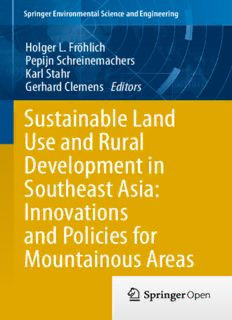
Sustainable Land Use and Rural Development in Southeast Asia: Innovations and Policies for Mountainous Areas PDF
Preview Sustainable Land Use and Rural Development in Southeast Asia: Innovations and Policies for Mountainous Areas
Springer Environmental Science and Engineering Holger L. Fröhlich Pepijn Schreinemachers Karl Stahr Gerhard Clemens Editors Sustainable Land Use and Rural Development in Southeast Asia: Innovations and Policies for Mountainous Areas Sustainable Land Use and Rural Development in Southeast Asia: Innovations and Policies for Mountainous Areas Springer Environmental Science and Engineering For furthervolumes: http://www.springer.com/series/10177 Holger L. Fro¨hlich (cid:129) Pepijn Schreinemachers (cid:129) Karl Stahr (cid:129) Gerhard Clemens Editors Sustainable Land Use and Rural Development in Southeast Asia: Innovations and Policies for Mountainous Areas Editors HolgerL.Fro¨hlich PepijnSchreinemachers KarlStahr GerhardClemens UniversityofHohenheim Stuttgart Germany ISSN2194-3214 ISSN2194-3222(electronic) ISBN978-3-642-33376-7 ISBN978-3-642-33377-4(eBook) DOI10.1007/978-3-642-33377-4 SpringerHeidelbergNewYorkDordrechtLondon LibraryofCongressControlNumber:2013931110 #TheEditor(s)andtheAuthor(s)2013.ThebookispublishedwithopenaccessatSpringerLink.com Open Access This book is distributed under the terms of the Creative Commons Attribution Non- commercial License which permits any noncommercial use, distribution, and reproduction in any medium,providedtheoriginalauthor(s)andsourcearecredited. All commercial rights are reserved by the Publisher, whether the whole or part of the material is concerned, specifically the rights of translation, reprinting, re-use of illustrations, recitation, broad- casting, reproduction on microfilms or in any other way, and storage in data banks. Duplication of this publicationor parts thereofis permitted only under the provisionsof the Copyright Law of the Publisher’slocation,initscurrentversion,andpermissionforcommercialusemustalwaysbeobtained fromSpringer.PermissionsforcommercialusemaybeobtainedthroughRightsLinkattheCopyright ClearanceCenter.ViolationsareliabletoprosecutionundertherespectiveCopyrightLaw. Theuseofgeneraldescriptivenames,registerednames,trademarks,servicemarks,etc.inthispubli- cationdoesnotimply,evenintheabsenceofaspecificstatement,thatsuchnamesareexemptfromthe relevantprotectivelawsandregulationsandthereforefreeforgeneraluse. While the advice and information in this book are believed to be true and accurate at the date of publication,neithertheauthorsnortheeditorsnorthepublishercanacceptanylegalresponsibilityfor anyerrorsoromissionsthatmaybemade.Thepublishermakesnowarranty,expressorimplied,with respecttothematerialcontainedherein. Printedonacid-freepaper SpringerispartofSpringerScience+BusinessMedia(www.springer.com) Foreword Twenty years ago, in 1992, mountains were formally included in the global environmentanddevelopmentagenda,withthepublicationofChap.13—‘Manag- ingFragileEcosystems:SustainableMountainDevelopment’—in‘Agenda21’,the plan for action signed by the heads of state or government of most of the world’s nations at the United Nations Conference on Environment and Development, or ‘Earth Summit’ held in Rio de Janeiro (Debarbieux and Price 2008). Chapter 13 includestwo‘programmeareas’: (cid:129) Generating and strengthening knowledge about the ecology and sustainable developmentofmountainecosystems (cid:129) Promoting integrated watershed development and alternative livelihood opportunities Since 1992, under the aegis of the Food and Agriculture Organization of the UnitedNations(FAO)as‘TaskManager’forChapter13,considerableprogresshas been made towards the goals of Chapter 13 (Price 1999; Kohler et al. 2012; Messerli 2012). In 1994, FAO convened the Inter-Agency Group on Mountains, whichrecommendedatitsfirstmeetingthatnationalgovernmentsshouldbecome directlyinvolvedintheimplementationofChapter13.Oneoutcomewasaseriesof regional intergovernmental consultations. The first of these, in December 1994, broughttogetherrepresentativesofgovernmentsfromtheAsiaandPacificregions including, from Southeast Asia, Indonesia, Laos, Myanmar, the Philippines, Thailand,andVietnam(BanskotaandKarki1995).Thisrecognitionoftheimpor- tanceofmountainsintheregioncanbelinkedtothefactthat35%oftheareaof Southeast Asia and Oceania as a whole is mountainous, with particularly high percentagesinLaos(72%),Myanmar(49%),Vietnam(40%),andthePhilippines (37 %). However, while the total mountain population of the region in 2000 was over 52 million, of whom 20 % were urban, only one of these countries has a particularlyhighproportionofitspopulationlivinginmountainareas:Laos(42%); inothers,theproportionislessthan10%(Huddlestonetal.2003).Nevertheless,in this region, as for many others around the world, the importance of mountains can be evaluated not only in terms of their area and population but also the v vi Foreword many ecosystem services they provide to much larger populations (Ko¨rner and Ohsawa2005). In2002,manyeventswereheldthroughoutthemountainsofSoutheastAsiaas part of the International Year of Mountains. In the same year, the Mountain Partnership was established, as a ‘voluntary alliance of partners dedicated to improving the lives of mountain people and protecting mountain environments around the world’ (www.mountainpartnership.org/about/en). As of 2012, it includes nearly 200 members. However, few are from Southeast Asia: the Asian Development Bank, the Government of Indonesia, and two NGOs based in the Philippines. Inthiscontext,thisbookispotentiallyofgreatimportance.Whileitisbasedon researchinonlytwoofSoutheastAsia’scountries,itcertainly contributestoboth programme areas of Chapter 13, and the in-depth research it reports should be of usemorewidely,notonlywithinthemountainsofthesetwocountries,butalsoof othersintheregion.Itisanexcellentexampleoflong-termand‘North-South’and also ‘South-South’ collaboration across many disciplines. At the same time, this book only presents some of the outcomes; many more, most of much wider relevance, were presented at the final conference of the ‘Uplands Program’ in April2012.Critically,participantsatthisconference—includingtherepresentative of the German Research Foundation, the main funder of the programme— recognised the need for the valuable results of this research programme to be widely disseminated not only through this book, but through many other means, inordertoreachnotonlythescientistsandruraldevelopmentexpertswhoarethe majoraudienceforthisbook,butalsofarmers,extensionagents,decision-makers, andmanyothersconcernedwith sustainablemountaindevelopment.Thefocusof theplannedactivitieswillprimarilybeinThailandandVietnam;Iwouldurgefar widerdisseminationacrossthemountainsofSoutheastAsia.Moregenerally,Ihope thatthecollaborationdevelopedthroughtheUplands Program,which hasalready spreadtoYunnan,canbemorewidelydevelopedacrossthemountainsofSoutheast Asia, recognising the benefits of learning from experience and sharing good practices—andthatthiscanbethebeginningofeffectiveandlong-lastingcoopera- tion to benefits the many millions of people living in, and dependent on, the mountainsofthisimportantregion. ProfessorMartinPrice Director,CentreforMountainStudies,PerthCollege, UniversityoftheHighlandsandIslands,Scotland Chairholder,UNESCOChairinSustainableMountainDevelopment References BanskotaM,KarkiAS(eds)(1995)Sustainabledevelopmentoffragilemountain areas of Asia. International Centre for Integrated Mountain Development, Kathmandu DebarbieuxB,PriceMF(2008)Representingmountains:fromlocalandnationalto globalcommongood.Geopolitics13:148–168 HuddlestonB,AtamanE,deSalvoP,ZanettiM,BloiseM,BelJ,FrancheschiniL, Fed’OstianiL(2003)TowardsaGIS-basedanalysisofmountainenvironments and populations. Food and Agriculture Organization of the United Nations, Rome Kohler T, Pratt J, Debarbieux B, Balsiger J, Rudaz G, Maselli D (eds) (2012) Sustainable mountain development, green economy and institutions. From Rio 1992 to Rio 2012 and beyond. Final Draft for Rio 2012. Swiss Agency for Development and Cooperation (SDC) and Centre for Development and Environment (CDE), University of Bern, Bern Ko¨rnerC,OhsawaM,SpehnE,BergeE,BugmannH,GroombridgeB,HamiltonL, HoferT,IvesJ,JodhaN,MesserliB,PrattJ,PriceM,ReasonerM,RodgersA, ThonellJ,YoshinoM(2005)Mountainsystems.In:HassanR,ScholesR,AshN (eds)Ecosystemsandhumanwell-being:currentstateandtrends,vol1.Millen- niumecosystemassessment.IslandPress,Washington,DC,pp681–716 MesserliB(2012)Globalchangeandtheworld’smountains.MtResDev32(S1): 55–63 PriceMF(1999)Chapter13inaction:ataskmanager’sreport.FoodandAgricul- tureOrganizationoftheUnitedNations,Rome vii . Contents PartI Introduction 1 FromChallengestoSustainableSolutionsforUplandAgriculture inSoutheastAsia. . . .. . . . . .. . . . .. . . . . .. . . . .. . . . . .. . . . . .. 3 PepijnSchreinemachers,HolgerL.Fro¨hlich,GerhardClemens, andKarlStahr PartII EnvironmentalandSocialChallenges 2 BeyondtheHorizons:ChallengesandProspectsforSoilScience andSoilCareinSoutheastAsia. . . . . . . . . . . . . . . . . . . . . . . . . . . 31 KarlStahr,GerhardClemens,UlrichSchuler,PetraErbe,VolkerHaering, NguyenDinhCong,MichaelBock,VuDinhTuan,HeinrichHagel, BuiLeVinh,WanidaRangubpit,AdichatSurinkum,JanWiller, JoachimIngwersen,MehdiZarei,andLudgerHerrmann 3 WaterandMatterFlowsinMountainousWatersheds ofSoutheastAsia:ProcessesandImplicationsforManagement. . . 109 HolgerL.Fro¨hlich,JoachimIngwersen,PetraSchmitter,MarcLamers, ThomasHilger,andIvenSchad 4 AgriculturalPesticideUseinMountainousAreasofThailandand Vietnam:TowardsReducingExposureandRationalizingUse. . . . 149 MarcLamers,PepijnSchreinemachers,JoachimIngwersen, WalayaSangchan,ChristianGrovermann,andThomasBerger 5 LinkagesBetweenAgriculture,PovertyandNaturalResourceUse inMountainousRegionsofSoutheastAsia. . . . . . . . . . . . . . . . . . . 175 CamilleSaint-Macary,AlwinKeil,TheaNielsen,AthenaBirkenberg, LeThiAiVan,DinhThiTuyetVan,SusanneUfer,PhamThiMyDung, FranzHeidhues,andManfredZeller ix
Description: